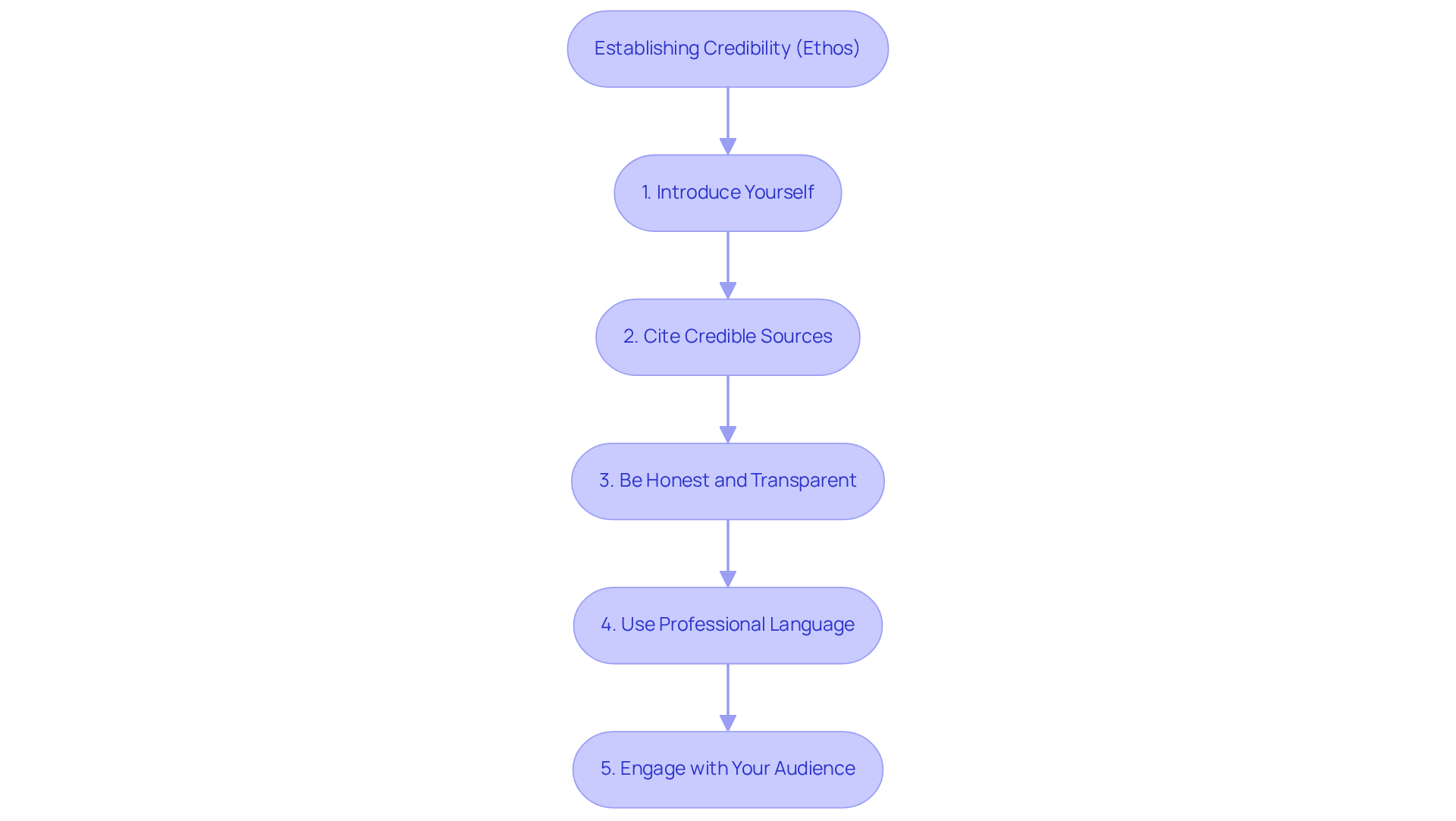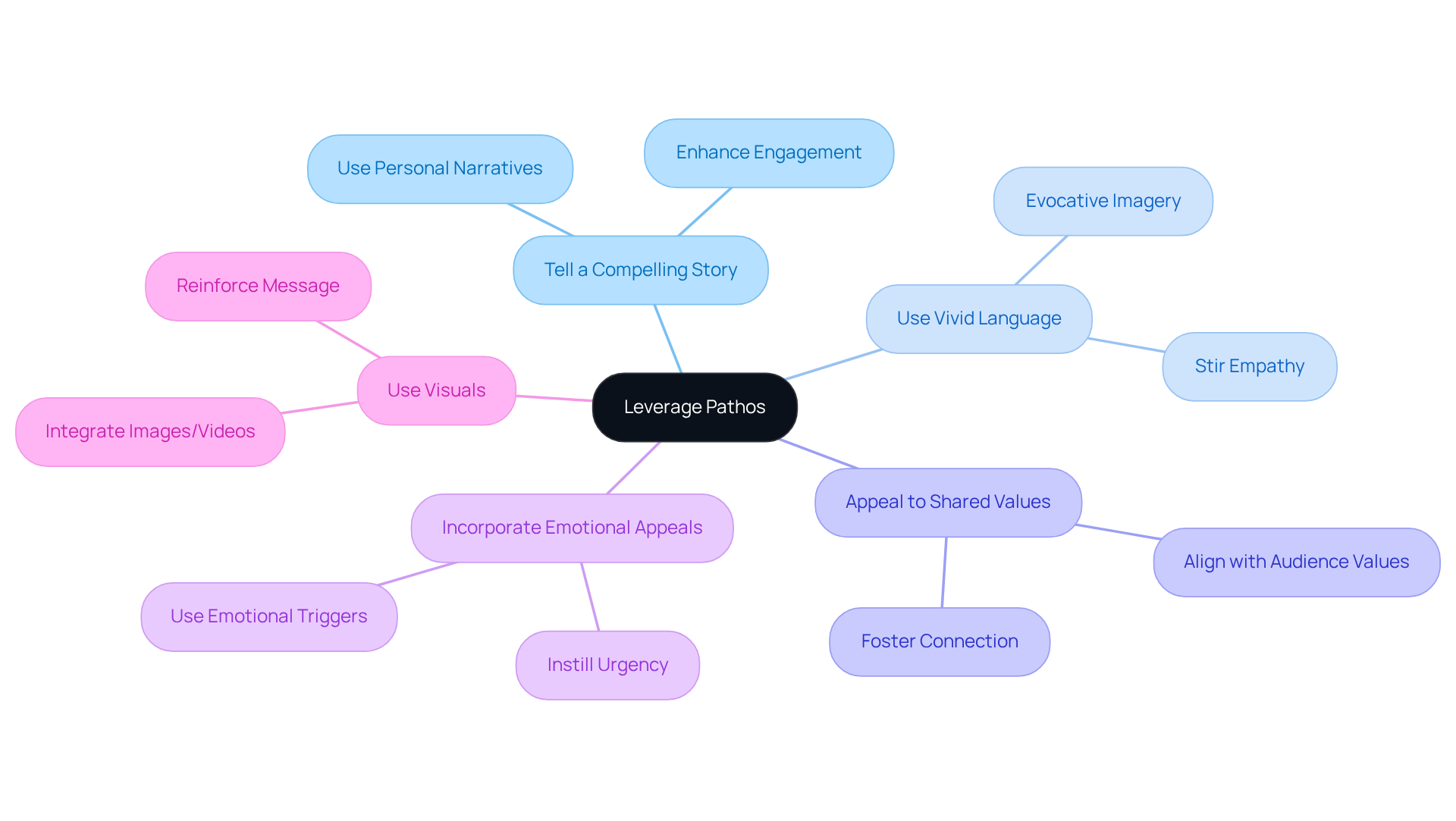
Overview
This article delves into the mastery of persuasive techniques, crucial for enhancing arguments effectively. It underscores the importance of:
- Ethos—credibility
- Pathos—emotional appeal
- Logos—logical reasoning
By establishing credibility through qualifications and reputable sources, engaging audiences emotionally via compelling stories and vivid language, and crafting logical arguments supported by evidence, these techniques collectively contribute to making arguments not only more persuasive but also significantly impactful. The actionable strategies provided serve as essential tools for anyone looking to elevate their argumentative prowess.
Introduction
Mastering the art of persuasion is not merely an academic exercise; it is a transformative skill that can elevate ordinary arguments into compelling narratives that resonate deeply with audiences. By understanding and effectively employing techniques such as ethos, pathos, and logos, individuals can significantly enhance their communication skills and wield greater influence over others.
Yet, the challenge remains: how can one achieve a delicate balance between credibility, emotional appeal, and logical reasoning to craft arguments that not only persuade but also inspire action?
This guide delves into the intricacies of persuasive techniques, offering actionable strategies designed to elevate arguments and engage listeners on multiple levels.
Understand Ethos: Establishing Credibility in Your Argument
To establish ethos effectively, begin by clearly relevant to the topic. Here are actionable steps:
- Introduce Yourself: Start with a brief introduction that highlights your expertise. For instance, if discussing marketing strategies, mention your years of experience and notable achievements, as this builds immediate trust.
- Cite Credible Sources: Support your claims with data and references from reputable sources. Studies show that listeners are more inclined to embrace claims supported by reliable information, boosting the overall effectiveness of your message. For example, 68% of people see someone who has expertise in their field as a thought leader, which underscores the importance of establishing credibility.
- Be Honest and Transparent: Acknowledge any potential biases or limitations in your argument. This honesty not only enhances your credibility but also fosters trust, as it shows that you are not trying to manipulate the listeners.
- Use Professional Language: Maintain a formal tone and avoid slang or overly casual language. This approach conveys seriousness and professionalism, reinforcing your authority on the subject.
- Engage with Your Audience: Make eye contact (if speaking) or use direct language (if writing) to connect with your audience. Engaging in this manner can significantly enhance your perceived credibility, as it shows you value their attention and input. Furthermore, keep in mind that more than 90% of communication is expressed through body language, so ensure your non-verbal signals are in harmony with your intent.
By following these steps, you can effectively establish your credibility, which is a writing or speaking technique that helps to make arguments more persuasive and impactful. Remember, credibility is a fundamental aspect of persuasive communication, serving as a writing or speaking technique that helps to make arguments more persuasive and influencing how those receiving your content perceive and react to it. As noted, "Credibility is a core element of persuasive communication and one of the most vital leadership qualities," highlighting its significance in your efforts.

Leverage Pathos: Engaging Your Audience Emotionally
To effectively leverage pathos, consider the following strategies:
- Tell a Compelling Story: Employ anecdotes or personal narratives that resonate with the experiences of your audience. For example, when advocating for a charity, share a heartfelt story about an individual whose life was transformed by the organization’s support. Research indicates that personal stories can significantly enhance engagement, rendering the message more relatable and impactful.
- Use Vivid Language: Utilize that evokes strong imagery and emotions. Rather than stating, "many people suffer from hunger," create a vivid picture: "Imagine a child going to bed hungry, dreaming of a meal that never comes." Such imagery can stir empathy and motivate action.
- Appeal to Shared Values: Identify and align your argument with the values that matter to your listeners. If your audience prioritizes community, emphasize how your proposal promotes community well-being. This alignment fosters a deeper connection and increases receptiveness to your communication.
- [Incorporate Emotional Appeals](https://climatecommunication.yale.edu/publications/personal-climate-stories-can-persuade): Leverage emotional triggers such as fear, hope, or joy to forge a connection with your audience. Highlighting the consequences of inaction can instill a sense of urgency, prompting immediate responses. Research shows that emotional involvement can lead to substantial changes in consumer behavior, enhancing the persuasiveness of your communication.
- Use Visuals: When applicable, integrate images or videos that evoke emotions. A powerful visual can often convey more than words alone, reinforcing your message and enhancing emotional resonance.
By incorporating a writing or speaking technique that helps to make arguments more persuasive, you can establish a strong emotional bond with your listeners, making your points not only more persuasive but also more likely to inspire action.

Utilize Logos: Crafting Logical Arguments for Clarity
To effectively utilize logos in your arguments, consider the following strategies:
- Present Clear Evidence: Support your claims with statistics, facts, and logical reasoning. When advocating for a new policy, showcase data that highlights its success in similar contexts. As James Greer notes, "Your statistical analysis should support your premise both with the raw data as well as the statistical analysis." This method not only reinforces your case but also among your listeners.
- Structure Your Argument: Organize your points in a logical sequence. Begin with a clear thesis statement, followed by well-organized supporting points, and conclude with a compelling summary. This clarity allows your audience to follow your reasoning effortlessly.
- Use Analogies and Comparisons: Relate complex ideas to familiar concepts through analogies. For instance, contrasting a new technology with a familiar product effectively demonstrates its benefits, enhancing your point's relatability and clarity.
- Anticipate Counterarguments: Proactively address possible objections to your position. Recognizing differing perspectives shows comprehensive thought on the subject and strengthens your stance, making your case more robust. This aligns with the notion that effective argumentation involves understanding the background of data and potential biases in interpretation.
- Be Concise and Clear: Avoid jargon and overly complex language. Strive for clarity to ensure your listeners can easily grasp your reasoning. Clear communication is essential for effective persuasion. Remember, as noted in the case study on the importance of reliable sources, sourcing statistics from credible origins minimizes the risk of misrepresentation.
By implementing these strategies, which include a writing or speaking technique that helps to make arguments more persuasive, you can create logical arguments that resonate with your audience, significantly enhancing your persuasive efforts in both writing and marketing.

Conclusion
Mastering persuasive techniques is essential for anyone looking to enhance their arguments effectively. Establishing credibility through ethos, engaging emotions with pathos, and crafting clear logical arguments using logos are fundamental strategies that empower communicators to connect with their audience on multiple levels. By integrating these elements, arguments become more compelling and influential, ultimately leading to greater success in persuasion.
The article outlines practical steps to establish ethos, such as:
- Presenting qualifications
- Citing credible sources
- Engaging with the audience
It emphasizes the power of pathos through:
- Storytelling
- Vivid language
- Emotional appeals
While also highlighting the importance of logos by advocating for:
- Clear evidence
- Logical structure
- Anticipating counterarguments
Each of these approaches serves to enhance the overall effectiveness of communication, making arguments not only persuasive but also resonant and memorable.
Incorporating these persuasive techniques can transform the way arguments are received and understood. Whether in writing or speaking, the ability to connect with an audience through credibility, emotion, and logic is invaluable. As individuals strive to master these skills, they should embrace the potential of persuasive communication to inspire action, foster understanding, and create meaningful dialogues.
Frequently Asked Questions
What is ethos and why is it important in communication?
Ethos refers to establishing credibility in your argument, which is crucial for persuasive communication. It influences how the audience perceives and reacts to your message.
How can I effectively establish my ethos?
You can establish your ethos by clearly presenting your qualifications, citing credible sources, being honest and transparent, using professional language, and engaging with your audience.
What should I include in my introduction to build credibility?
Your introduction should highlight your expertise, including your years of experience and notable achievements relevant to the topic at hand.
Why is it important to cite credible sources?
Citing credible sources supports your claims with reliable information, making your argument more persuasive. Studies show that audiences are more likely to trust claims backed by reputable data.
How does honesty and transparency affect my credibility?
Acknowledging potential biases or limitations in your argument enhances your credibility. It fosters trust by demonstrating that you are not attempting to manipulate the audience.
What type of language should I use to maintain professionalism?
You should use formal language and avoid slang or overly casual expressions, as this conveys seriousness and reinforces your authority on the subject.
How can I engage with my audience to enhance my credibility?
Engage with your audience by making eye contact (if speaking) or using direct language (if writing). This shows you value their attention and input, which can enhance your perceived credibility.
What role does body language play in establishing credibility?
Body language plays a significant role in communication, as more than 90% of communication is non-verbal. Ensuring your non-verbal signals align with your message can enhance your credibility.
What is the overall significance of credibility in communication?
Credibility is a core element of persuasive communication and is considered one of the most vital leadership qualities, impacting the effectiveness of your arguments.
FAQs











